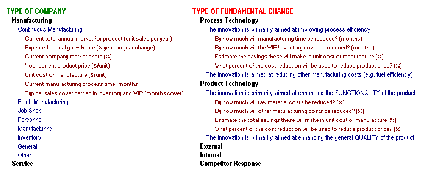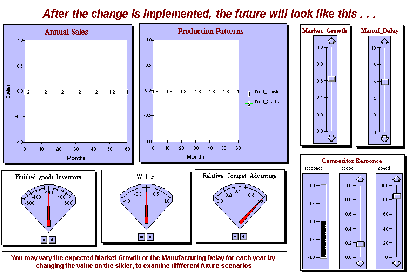
Abstract
Firms planning fundamental change, whether driven
by technology breakthrough or other structural changes, face particular
problems not typically encountered in incremental change situations.
Research is progressing on the development of a change framework
to assist organisations facing such change. This framework includes
a "change visioning" support tool which will configure
itself to the envisioned new organisation through an interrogative
session with the key change initiator(s). The tool can then be
used as a flight simulator by key managers to enable them to pre-experience,
learn about, and experiment with the new organisation, and then
develop appropriate new thinking. This paper describes how this
framework is emerging from the change management literature and
case research, and addresses some of the modelling and interface
issues in designing the Computer-Aided Visioning (CAV) tool.
Coping with change
Traditional research and publications on change management have
tended to focus their attention on the planning and implementation
phases, with relatively little emphasis on the needs of the managers
in the new, post-change organisation - many of whom may not be
directly involved with change implementation. Managers in incremental
change situations can, with reasonable confidence, use their current
experiences, practice, and modes of operation as their starting
points for new thinking, and this can evolve as the change is
implemented. Fundamental changes however may thrust managers into
totally alien decision environments, and these managers need new
tools to help them "cope with change".
A survey of general management texts and papers has revealed a
tendency to refer to the importance of generating vision without
specifying how this can be engendered. In the learning organisation
literature, for example, the views of Garratt (1994) are typical
in suggesting that senior managers frequently lack the training
and development tools which would maximise their effectiveness.
At the same time, much of the general literature on major change
focuses on quality or BPR frameworks but tends to be based on
one or two consultancy based case studies or surveys - see, for
example, Coulson Thomas (1992) and Aitken (1995). Regrettably,
however, these only offer general guidelines and models of change
which fail to address how precisely vision is generated and how
it can address the dynamics of individual managers mental models
and changing scenarios. Many such transformations are reported
subsequently as failing - Barrett (1994) suggests that up to one
third of all BPR initiatives fail because they do not accurately
visualise the future business processes. He calls for narrative
and descriptive scenario planning and the use of computer models
to assist management. Surprisingly little further reference is
made to making use of IT for visioning or more creative purposes,
though Winch et al. (1997) postulate a much broader role
for IT which includes a visioning capability to provide a whole
system view particularly in network-form or "extended enterprise"
organisations.
A research programme at Plymouth is investigating the processes
of major change implementation, specifically how firms prepare
their senior managers for the changing roles and environments
that change will force upon them. Through literature and case-study
investigations, a framework for change is being developed which
includes a "computer-aided visioning" tool - a CAV -
that will enable such managers to pre-experience their new circumstances
through a management flight simulator.
Communicating vision in major change situations
Preliminary results have been compiled from a series of qualitative
case studies with managers in organisations which have undergone
at least one fundamental change in the recent past, with six manufacturing
businesses so far surveyed. Initially, an extended interview is
conducted with the senior managers in each firm who had been involved
in the initiation of fundamental change decisions (change initiators).
This interview focuses on how the skills and knowledge base of
key managerial talent was enhanced and developed. Following these,
validating interviews are conducted with between three and five
managers from each business who either had some responsibility
for the implementation of the change, or whose roles were altered
in some significant way ("post-change managers"). Follow
up sessions have also involved further meetings with the change
initiators to introduce a demonstration management simulator (described
below), and to gauge how such tools can be enhanced to meet the
expectations of these business leaders as they contemplate further
fundamental change.
This work has already produced a large source of primary data
which is currently being analysed. Initial findings have thrown
up a variety of issues which highlight a lack of understanding
amongst senior managers concerning the process of preparing both
themselves and their staff for fundamental change. In management
development terms, a particular need to align the views of key
managers to the vision of change initiators has been identified.
This is particularly appropriate for four of the sample classified
as "high growth SME's". In these firms a lack of planning
was found concerning the development of managerial thinking amongst
promoted supervisors and foremen, on whom the growing firms will
rely for their management cadre in the future. Another key area
where failings appeared widespread was communication, both vertical
and horizontal. New IT systems were producing tangible benefits
in some of the firms where 'rogue' departments had traditionally
been resistant to any change, but one middle manager from a vehicle
equipment manufacturer had no idea about the turnover / profitability
of the firms US sister company which manufactured a significant
amount of the UK firm's turnover. In the case of vertical communication,
a surprising lack of feedback mechanisms is in evidence, even
in firms with as few as a hundred employees.
In terms of the development of learning and knowledge, two principal
issues are beginning to emerge: firstly, the importance of utilising
external stakeholder sources of learning and knowledge, and, secondly,
the benefits of replacing and/or creating new staff positions
to meet the needs of their new environment. One Finance Director
of a manufacturer of high tech security systems said the best
decision they had taken regarding the change was to bring new
staff into the company at a very early stage, before a normal
assessment of the firms finances could justify this. Internal
skills enhancement also seems to have been neglected as firms
dealt with the 'hard issues' related to the change, though it
is also clear that the growth in popularity of externally assessed
quality initiatives have at last focused management attention
on this key responsibility. One manager in a manufacturer of equipment
for the petroleum industry cheerfully recalled how he dealt with
a series of new duties relating to the introduction of a new product
line and a rapid expansion of sales. At this point he asked for
the recording of the interview to stop and then admitted that
he had suffered a nervous breakdown. This is, perhaps, one particularly
harsh example of the difference between the rhetoric and actual
commitment.
In terms of capacity and ability to plan changes, a pattern is emerging of fundamental change being initiated primarily as a reactive response to a deterioration in traditional markets. The emphasis of managerial thinking tended to be on internal re-organisation and short term benefits, rather than one which focused on market expectations; formal plans tended to be either absent or not circulated. Despite the importance of external stakeholder knowledge in our findings there was virtually no serious attempt to bring in suppliers into the planning loop. In two of the SME's succession planning would also clearly be a vital area for the companies, yet it was clear that the implications and possible consequences for the businesses had been evaluated in the most cursory manner.
A framework to support preparations for fundamental change
The research to date is pointing towards a number of critical
success factors to ensure that managers within an organisation
can "hit the ground running", that is, making sure they
can be fully effective in their new environment as quickly as
possible after the change. The case research has suggested that
this is unlikely be the case, and that many mangers are seriously
unprepared for what the change brings. This could be expected
to be particularly true for those whose roles change in a major
way, but who have not been centrally involved in planning and
implementing the change. Simply developing and refining skills
may be part of the process, as junior managers take on more senior
roles, new staff come into the firm, and management processes
evolve. However with major change, there may be severe discontinuities
that command fundamentally different ways of thinking - former
competitors may become allies in joint ventures, firms that used
to operate through traditional supplier/customer trading become
integrated supply-chain partners, or firms historically operating
within their local markets go global.

A significant feature of the framework being developed to support
organisations in preparing for fundamental change is a computer-aided
visioning tool. Briefly, the concept is that tool supports the
process by enabling the change initiators to articulate their
vision of the changed organisation through a detailed inter-rogatory.
Figure 1 shows an extract from the question bank of over
a thousand questions that can be called dynamically by the interrogatory
interface to characterise the organisation and the change. (The
questions are layered in colour-coded strata.) The vision that
results from this process is then automatically captured within
a system dynamics model that is calibrated to the firm and its
expected future changed operations and relationships, as determined
by the change initiators' input. The model itself forms the core
of a flight simulator that then enables other managers to pre-experience
the changed organisation, trying out their old ways of doing things
and testing their old ways of thinking.

Currently a demonstrator is available that offers simple functionality.
It permits a simple interrogatory session with the scope being
confined to process technology changes in a manufacturing environ-ment.
The captured data - parameters to define the organisation and
the change and to calibrate the model - are then transferred to
a generic system dynamics model through a DDI. The interface has
been developed within an Excel® spreadsheet structure
which interfaces easily with the generic model constructed in
PowerSim®. Access to the model is by a typical
flight simulator interface, and Figure 2 shows the interface
that would result from representative answers to the Figure
1 question bank.
Conclusions
Research to date has highlighted a number of key factors to be
addressed as organisations face major changes driven by technological
breakthroughs and the changing global business scene, and by new
organisational structures being designed to meet these challenges.
Broadly these include:
A framework is being developed to support organisations in preparing
for planned major change that includes a model-based tool for
delivering to key managers a way of pre-experiencing the envisaged
post-change situation, and a CAV demonstrator is currently available
and being trialed.
References
Aitken, A & I. Saunders, 1995, "Vision only
works if communicated", People Management,
1(25), pp. 28-31
Barrett, J. L., 1994, "Process visualisation:
Getting the vision right is the key", Information Systems
Management, 11 (2) pp. 14-23
Coulson Thomas, C., 1992, "Strategic vision
or strategic con?: Rhetoric or reality" Long Range
Planning, 25 (1) pp. 81-89
Garratt, Bob, 1994, The Learning Organisation
and the Need for Directors Who Think, Harper-Collins, London
Winch, G. W., H. Gyllstrom, F. Sauer, & S. Seror-Marklin, 1997, "The virtual neural business system: a vision for IT support for the network form organisation", Management Decision, 35 (1), pp. 40-48